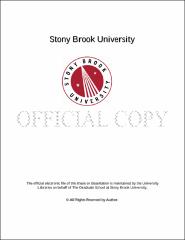| dc.identifier.uri | http://hdl.handle.net/11401/77558 | |
| dc.description.sponsorship | This work is sponsored by the Stony Brook University Graduate School in compliance with the requirements for completion of degree. | en_US |
| dc.format | Monograph | |
| dc.format.medium | Electronic Resource | en_US |
| dc.language.iso | en_US | |
| dc.publisher | The Graduate School, Stony Brook University: Stony Brook, NY. | |
| dc.type | Dissertation | |
| dcterms.abstract | If 21<super>st</super> century students can ask their mobile devices questions and receive nearly instant answers, how then can 21<super>st</super> century teachers enact an engaged pedagogy? One possibility is by learning with and in front of students, thus creating <&ldquo>fourth space<&rdquo>--a space in which teachers embody praxis and become simultaneous models of and participants in education. This dissertation provides a new framework for English Teacher Education that centers on fourth space and the ways that teachers and students can engage in critical contact zones from within it. Drawing on critical pedagogy, combining various perspectives about identity formation and reflection theories in teacher education, and applying these to current social and political landscapes of education will highlight the need for teachers to no longer act as a <&ldquo>sage on the stage<&rdquo> or a <&ldquo>guide on the side,<&rdquo> but instead be a <&ldquo>mentor in the center,<&rdquo> enacting an engaged, democratic pedagogy with students. I advocate for such mentorship to take place in online communities, using autoethnography as a vehicle for engagement in individual and collective contact zones. In the second half of the dissertation, I present a study conducted with preservice English teachers that shows the benefits of creating collaborative learning experiences such as <&ldquo>open<&rdquo> reflection and autoethnographic composition in multimodal forms (video, infographics, etc.) and the ways that these shaped preservice teachers' identities. Finally, I introduce the Fourth Space Protocol, which teacher educators and inservice secondary teachers can use to plan, create, and reflect on their own spaces that will shape theory, practice and identity formation in learning communities. By using this protocol, teachers of English in high school and college classrooms can publicly reflect on practice for and with students in order to embody the concept of praxis and act as <&ldquo>living examples<&rdquo> of democratic education in the 21<super>st</super> century. | |
| dcterms.available | 2017-09-20T16:52:54Z | |
| dcterms.contributor | Khost, Peter | en_US |
| dcterms.contributor | Lindblom, Ken | en_US |
| dcterms.contributor | Dunn, Patricia | en_US |
| dcterms.contributor | Hyman, David. | en_US |
| dcterms.creator | Galante, Nicole | |
| dcterms.dateAccepted | 2017-09-20T16:52:54Z | |
| dcterms.dateSubmitted | 2017-09-20T16:52:54Z | |
| dcterms.description | Department of English. | en_US |
| dcterms.extent | 88 pg. | en_US |
| dcterms.format | Application/PDF | en_US |
| dcterms.format | Monograph | |
| dcterms.identifier | http://hdl.handle.net/11401/77558 | |
| dcterms.issued | 2014-12-01 | |
| dcterms.language | en_US | |
| dcterms.provenance | Made available in DSpace on 2017-09-20T16:52:54Z (GMT). No. of bitstreams: 1
Galante_grad.sunysb_0771E_12098.pdf: 535735 bytes, checksum: 7948247f370b99d5a6859d0a43ea9e06 (MD5)
Previous issue date: 1 | en |
| dcterms.publisher | The Graduate School, Stony Brook University: Stony Brook, NY. | |
| dcterms.subject | Education | |
| dcterms.subject | Critical Pedagogy, Democratic Education, Fourth Space, Praxis, Teacher Education | |
| dcterms.title | Teaching and Learning in Fourth Space: Embodying Praxis, Becoming Role Model | |
| dcterms.type | Dissertation | |

